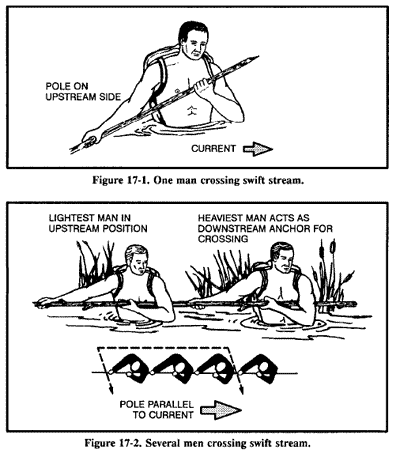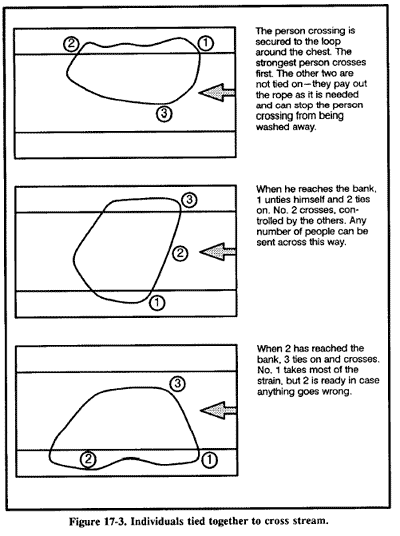Expedient Water Crossings - Rapids
If necessary, you can safely cross a deep, swift river or rapids. To swim
across a deep, swift river, swim with the current, never fight it. Try to keep your body horizontal to the water. This will reduce the danger of being pulled under.
In fast, shallow rapids, lie on your back, feet pointing downstream, finning
your hands alongside your hips. This action will increase buoyancy and help you steer away from obstacles. Keep your feet up to avoid getting them bruised or caught by rocks.
In deep rapids, lie on your stomach, head downstream, angling toward the shore whenever you can. Watch for obstacles and be careful of backwater
eddies and converging currents, as they often contain dangerous swirls. Converging currents occur where new watercourses enter the river or where water has been diverted around large obstacles such as small islands.
To ford a swift, treacherous stream, apply the following steps:
- Remove your pants and shirt to lessen the waterís pull on you. Keep your footgear on to protect your feet and ankles from rocks. It will also provide you with firmer footing.
- Tie your pants and other articles to the top of your rucksack or in a bundle, if you have no pack. This way, if you have to release your equipment, all your articles will be together. It is easier to find one large pack than to find several small items.
- Carry your pack well up on your shoulders and be sure you can easily
remove it, if necessary. Not being able to get a pack off quickly enough can drag even the strongest swimmers under.
- Find a strong pole about 7.5 centimeters in diameter and 2.1 to 2.4
meters long to help you ford the stream. Grasp the pole and plant it
firmly on your upstream side to break the current. Plant your feet firmly with each step, and move the pole forward a little downstream from its previous position, but still upstream from you. With your next step, place your foot below the pole. Keep the pole well slanted so that the force of the current keeps the pole against your shoulder(Figure 17-1).
- Cross the stream so that you will cross the downstream current at a 45-degree angle.
Using this method, you can safely cross currents usually too strong for one person to stand against. Do not concern yourself about your packís weight, as the weight will help rather than hinder you in fording the stream.
If there are other people with you, cross the stream together. Ensure
that everyone has prepared their pack and clothing as outlined above. Position the heaviest person on the downstream end of the pole and the
lightest on the upstream end. In using this method, the upstream person breaks the current, and those below can move with relative ease in the eddy formed by the upstream person. If the upstream person gets temporarily swept off his feet, the others can hold steady while he regains his footing (Figure 17-2).

If you have three or more people and a rope available, you can use the technique shown in Figure 17-3 to cross the stream. The length of the rope must be three times the width of the stream.


Survival Skills
Survival Actions
Psyhology of Survival
Survival Planning and Survival Kits
Survival Medicine
Survival Medicine - Requirements for Maintenance of Health
Survival Medicine - Medical Emergencies
Survival Medicine - Lifesavings Steps
Survival Medicine - Bone And Joint Injury
Survival Medicine - Bites and Stings
Survival Medicine - Wounds
Survival Medicine - Environmental Injuries
Survival Medicine - Herbal Medicines
Shelters
Shelters - Shelter Site Selection
Shelters - Types of Shelters
Water Procurement - Water Sources
Water Procurement - Still Construction
Water Procurement - Water Purification
Firecraft - Basic Fire Principles
Firecraft - Site Selection and Preparation
Firecraft - Fire Material Selection
Firecraft - How to Build a Fire
Firecraft - How to Light a Fire
Food Procurement - Animals for Food
Food Procurement - Traps and Snares
Food Procurement - Killing Devices
Food Procurement - Fishing Devices
Food Procurement - Preparation of Fish and Game for Cooking and Storage
Survival Use of Plants - Edibility of Plants
Survival Use of Plants - Plants for Medicine
Poisonous Plants
Dangerous Animals - Insects and Arachnids
Dangerous Animals - Poisonous Snakes
Dangerous Animals - Dangerous Lizards
Dangerous Animals - Saltwater Dangers
Field-expedient Weapons, Tools, and Equipment
Field-expedient Weapons - Lashing and Cordage
Field-expedient Weapons - Rucksack Construction
Field-expedient Weapons - Clothing and Insulation
Field-expedient Weapons - Cooking and Eating
Desert Survival - Terrain
Desert Survival - Environmental Factors
Desert Survival - Need For Water
Desert Survival - Heat Casualties
Desert Survival - Precautions and Desert Hazards
Tropical Survival - Tropical Weather
Tropical Survival - Jungle Types
Tropical Survival - Travel Through Jungle Areas
Tropical Survival - Immediate Considerations
Tropical Survival - Water Procurement
Tropical Survival - Food
Cold Weather Survival - Cold Regions And Locations
Cold Weather Survival - Basic Principles Of Cold Weather Survival
Cold Weather Survival - Hygiene and Medical Aspects
Cold Weather Survival - Cold Injuries
Cold Weather Survival - Shelters
Cold Weather Survival - Fire
Cold Weather Survival - Water
Cold Weather Survival - Food
Cold Weather Survival - Travel
Cold Weather Survival - Weather Signs
Sea Survival - The Open Sea
Sea Survival - Seashores
Expedient Water Crossings - Rivers and Streams
Expedient Water Crossings - Rapids
Expedient Water Crossings - Rafts
Expedient Water Crossings - Flotation Devices
Expedient Water Crossings - Other Water Obstacles
Field-expedient Direction Finding - Using the Sun and Shadows
Field-expedient Direction Finding - Using the Moon and the Stars
Field-expedient Direction Finding - Making Improvised Compasses
Field-expedient Direction Finding - Other Means of Determining Direction
Signaling Techniques
Signaling Techniques - Means For Signaling
Signaling Techniques - Codes and Signals
Signaling Techniques - Aircraft Vectoring Procedures
Survival Movement in Hostile Areas - Phases of Planning
Survival Movement in Hostile Areas - Execution
Survival Movement in Hostile Areas - Return to Friendly Control
Camouflage - Personal Camouflage
Camouflage - Methods Of Stalking
Contact With People
Contact With People - The Survivorís Behavior
Survival In Man-made Hazards - The Nuclear Environment
Survival In Man-made Hazards - Biological Environments
Survival In Man-made Hazards - Chemical Environments
Survival Actions
Psyhology of Survival
Survival Planning and Survival Kits
Survival Medicine
Survival Medicine - Requirements for Maintenance of Health
Survival Medicine - Medical Emergencies
Survival Medicine - Lifesavings Steps
Survival Medicine - Bone And Joint Injury
Survival Medicine - Bites and Stings
Survival Medicine - Wounds
Survival Medicine - Environmental Injuries
Survival Medicine - Herbal Medicines
Shelters
Shelters - Shelter Site Selection
Shelters - Types of Shelters
Water Procurement - Water Sources
Water Procurement - Still Construction
Water Procurement - Water Purification
Firecraft - Basic Fire Principles
Firecraft - Site Selection and Preparation
Firecraft - Fire Material Selection
Firecraft - How to Build a Fire
Firecraft - How to Light a Fire
Food Procurement - Animals for Food
Food Procurement - Traps and Snares
Food Procurement - Killing Devices
Food Procurement - Fishing Devices
Food Procurement - Preparation of Fish and Game for Cooking and Storage
Survival Use of Plants - Edibility of Plants
Survival Use of Plants - Plants for Medicine
Poisonous Plants
Dangerous Animals - Insects and Arachnids
Dangerous Animals - Poisonous Snakes
Dangerous Animals - Dangerous Lizards
Dangerous Animals - Saltwater Dangers
Field-expedient Weapons, Tools, and Equipment
Field-expedient Weapons - Lashing and Cordage
Field-expedient Weapons - Rucksack Construction
Field-expedient Weapons - Clothing and Insulation
Field-expedient Weapons - Cooking and Eating
Desert Survival - Terrain
Desert Survival - Environmental Factors
Desert Survival - Need For Water
Desert Survival - Heat Casualties
Desert Survival - Precautions and Desert Hazards
Tropical Survival - Tropical Weather
Tropical Survival - Jungle Types
Tropical Survival - Travel Through Jungle Areas
Tropical Survival - Immediate Considerations
Tropical Survival - Water Procurement
Tropical Survival - Food
Cold Weather Survival - Cold Regions And Locations
Cold Weather Survival - Basic Principles Of Cold Weather Survival
Cold Weather Survival - Hygiene and Medical Aspects
Cold Weather Survival - Cold Injuries
Cold Weather Survival - Shelters
Cold Weather Survival - Fire
Cold Weather Survival - Water
Cold Weather Survival - Food
Cold Weather Survival - Travel
Cold Weather Survival - Weather Signs
Sea Survival - The Open Sea
Sea Survival - Seashores
Expedient Water Crossings - Rivers and Streams
Expedient Water Crossings - Rapids
Expedient Water Crossings - Rafts
Expedient Water Crossings - Flotation Devices
Expedient Water Crossings - Other Water Obstacles
Field-expedient Direction Finding - Using the Sun and Shadows
Field-expedient Direction Finding - Using the Moon and the Stars
Field-expedient Direction Finding - Making Improvised Compasses
Field-expedient Direction Finding - Other Means of Determining Direction
Signaling Techniques
Signaling Techniques - Means For Signaling
Signaling Techniques - Codes and Signals
Signaling Techniques - Aircraft Vectoring Procedures
Survival Movement in Hostile Areas - Phases of Planning
Survival Movement in Hostile Areas - Execution
Survival Movement in Hostile Areas - Return to Friendly Control
Camouflage - Personal Camouflage
Camouflage - Methods Of Stalking
Contact With People
Contact With People - The Survivorís Behavior
Survival In Man-made Hazards - The Nuclear Environment
Survival In Man-made Hazards - Biological Environments
Survival In Man-made Hazards - Chemical Environments